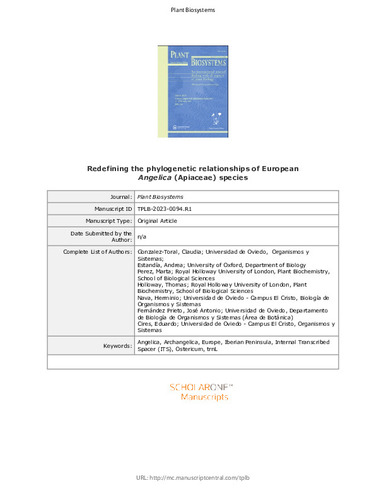Redefining the phylogenetic relationships of European Angelica (Apiaceae) species
Publication date:
Publisher version:
Citación:
Descripción física:
Abstract:
Angelica (Apiaceae) is a large complex genus with high morphological diversity. The many taxonomic treatments explain the controversy regarding the number of European species, which range from four to ten. Molecular methods have unraveled the complicated Asian and American taxonomies; however, no comprehensive molecular study has been conducted on the European taxa. We aim to determine the number of different European Angelica s.l. taxa and their relationship within the Selineae tribe by conducting Maximum Likelihood (ML) and Bayesian Inference (BI) analyses based on the nuclear Internal Transcribed Spacer (ITS) and haplotype networks by Templeton Crandall and Sing and neighbour-net analyses based on the plastid trnL. Three separate Iberian species (A. angelicastrum, A. razulii and A. pyrenaea) form the new Iberian Angelica clade, which is sister to the Archangelica clade. Although morphologically different, A. pachycarpa cannot be differentiated from A. angelicastrum by molecular methods, casting new doubts on the existing taxonomies. Molecular evidences suggest that A. heterocarpa should be considered an estuary forma of A. sylvestris. The east and west A. sylvestris subclades support the subspecies A. sylvestris subsp. elatior and A. sylvestris subsp. villosa (including A. heterocarpa). Our evidences support the classification of A. palustris as Ostericum palustre.
Angelica (Apiaceae) is a large complex genus with high morphological diversity. The many taxonomic treatments explain the controversy regarding the number of European species, which range from four to ten. Molecular methods have unraveled the complicated Asian and American taxonomies; however, no comprehensive molecular study has been conducted on the European taxa. We aim to determine the number of different European Angelica s.l. taxa and their relationship within the Selineae tribe by conducting Maximum Likelihood (ML) and Bayesian Inference (BI) analyses based on the nuclear Internal Transcribed Spacer (ITS) and haplotype networks by Templeton Crandall and Sing and neighbour-net analyses based on the plastid trnL. Three separate Iberian species (A. angelicastrum, A. razulii and A. pyrenaea) form the new Iberian Angelica clade, which is sister to the Archangelica clade. Although morphologically different, A. pachycarpa cannot be differentiated from A. angelicastrum by molecular methods, casting new doubts on the existing taxonomies. Molecular evidences suggest that A. heterocarpa should be considered an estuary forma of A. sylvestris. The east and west A. sylvestris subclades support the subspecies A. sylvestris subsp. elatior and A. sylvestris subsp. villosa (including A. heterocarpa). Our evidences support the classification of A. palustris as Ostericum palustre.
ISSN:
Patrocinado por:
Government of Asturias [2002166]; University of Oviedo [PAPI-19-GR-2016-0010]
We thank Dr. Polina A. Volkova for her contribution to the sampling effort. CGT had the financial support of the Government of Asturias (2002166- Programa Severo Ochoa). This research was partially supported by the research programme (PAPI-19-GR-2016-0010) funded by the University of Oviedo.
Collections
- Artículos [37543]
- Biología Funcional [801]
- Investigaciones y Documentos OpenAIRE [8377]
Files in this item





